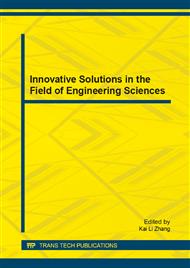[1]
D. C, Wilcox. Turbulence modeling for CFD , California DCW industies inc , (1993).
Google Scholar
[2]
Ziqiang Zhu. Applied Computational Fluid Dynamics [M]. Beijing University of Aeronautics and Astronautics Press, (1998).
Google Scholar
[3]
B, Bladwin., H, Lomax. Thin-Layer Approximation and Algebraic Model for Separation Flows AIAA Ppaer78一257, (1978).
Google Scholar
[4]
P. R, Spalart,S. R, Allmatas. A one-equation Turbulence Model for Aerodynamic Flows, AIAA paper 92-0439.
Google Scholar
[5]
W. P, Jones, B. E, Launder. The prediction of Laminarization with a two equation model of Turbulence , Int , Journal of Heat Mass Transfer , vol 15 pp.301-314 , (1972).
DOI: 10.1016/0017-9310(72)90076-2
Google Scholar
[6]
D. C, Wilcox. Reassessment of the scale-determing equation for advanced turbulence Models, AIAA Journal , vol26, pp.1299-1310, (1988).
DOI: 10.2514/3.10041
Google Scholar
[7]
B. E, Launder ,D. B, Spalding. Lectures in mathematical models of turbulence[M]. London.
Google Scholar
[8]
V, Yakhot ,S. A, Orszag. Renormalization group analysis of turbulence [J]. J. Scient Comput., 1986, 1: 3-11.
Google Scholar
[9]
T. H, Shih, W. W, Liou, A, Shabbir, et al. A new k-ε eddy viscosity model for high Reynolds number turbulent flows [J]. Comput. Fluids, 1995, 24: 227-238.
DOI: 10.1016/0045-7930(94)00032-t
Google Scholar
[10]
F. R, Menter. Two-equation eddy-viscosity turbulence models for engineering applications AIAA Journal August 1994; 32 (8): 1598-1605.
DOI: 10.2514/3.12149
Google Scholar
[11]
F. R, Menter. Zonal two equation k-ω turbulence models for engineering applications", AIAA Journal vol32, pp.1598-1605, (1994).
DOI: 10.2514/3.12149
Google Scholar
[12]
Shimin, TANG . Applications of SST turbulence model in prediction offlows with strong adverse pressure gradient [J]. Ship & Ocean Engineering, 2008, 37 (6) : 43-48. (In Chinese).
Google Scholar
[13]
B. E, Launder,G. J, Reece, W, Rodi. Progress in the developments of a Reynolds-stress Turbulence closure [J]. Journal of Fluid Mechanics , 1975, 68: 537-566.
DOI: 10.1017/s0022112075001814
Google Scholar
[14]
C. G Spezial. Analytical methods for the development of Reynolds-stress closures in turbulence . Annual Reviews Fluid Mechanics , 1991, 23: 107-157.
DOI: 10.1146/annurev.fl.23.010191.000543
Google Scholar
[15]
C. G Speziale, S. S, Thomas,B. Gatski. Modeling the pressure-strain correlation of turbulence: an invariant dynamical systems approach. Journal of Fluid Mechanics , 1991, 227: 245-272.
DOI: 10.1017/s0022112091000101
Google Scholar
[16]
H. G, Wang, S, Liu, F. Jiang. Separation characteristic of gas-solid flow in a u-beam separator using RSM model [A]. TMS Annual Meeting, Multiphase Phenomena in Material Processing, [C]. 2004: 551-581.
Google Scholar


